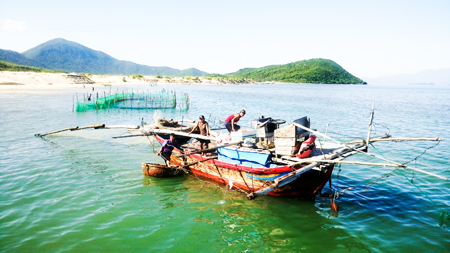
On November 29, Khanh Hoa Department of Agriculture & Rural Development held a meeting to listen to scientists' report on reasons for mass fish deaths in Vung Sim Waters, Van Ninh District...
On November 29, Khanh Hoa Department of Agriculture & Rural Development held a meeting to listen to scientists’ report on reasons for mass fish deaths in Vung Sim Waters, Van Ninh District.
 |
| Collecting dead fish at sea. |
Harmful algal bloom blamed
The fish deaths were not caused by diseases. The test on water samples taken at Vinh Yen Village Waters, Van Thanh Commune on November 24 shows environmental indexes pH, NH3, H2S, NO2-N and COD meeting national standard for seawater quality in aquaculture and marine creature reserve waters; surface water PO4 at 0.392mg/l, exceeding the standard level (0.2mg/l) and dissolved oxygen (DO) on the surface layer lower than the threshold limit. Remarkably, harmful dinoflagellate bloom was found such as Ceratium SP. (375,000 cells/ml) and Peridinium SP. (1,500 cells/ml) on the surface layer; and Ceratium SP. (262,000 cells/ml on the seabed layer. Harmful dinoflagellates developing in high concentrations cause depletion of dissolved oxygen, change environmental indexes and thus effect marine species. This is believed to be one of the reasons for the recent fish death in Van Ninh, according to Dang Hoang Giang San, Deputy Chief of the Environmental Office, Center for Monitoring Aquaculture Environment & Diseases in Central Region (Research Institute for Aquaculture III).
According to Nguyen Huu Huan, a representative of Nha Trang Institute of Oceanography, Ceratium SP. (375,000 cells/ml) and Peridinium SP. clinging to the fish gills blocked the fishr respiration. The high density of the dinoflagellates also matches satellite photos observed by Nha Trang Institute of Oceanography.
Representatives of Environmental Protection Branch (Khanh Hoa Department of Natural Resources & Environment) shared the same opinions, adding that the preliminary test on 4 water samples taken from the seabed layer in Van Ninh shows the high density of Ceratium SP., which matches the fish sample test result that the fish died from blocked respiration.
Le Tan Ban, Director of Khanh Hoa Department of Agriculture & Rural Development says, the reason for the mass fish death in Van Ninh is high concentrations of Ceratium SP. (375,000 cells/ml) and Peridinium boom known as the red tide, which is blamed for blocking aquatic respiration through gills and causing depletion of dissolved oxygen.
On November 29, Khanh Hoa Department of Agriculture & Rural Development submitted a report on the mass fish death and the reasons to the Ministry of Agriculture & Rural Development. Le Tan Ban directed management units under the department to continue monitoring the aquaculture waters and infected waters in Van Ninh in the following days; and suggested Khanh Hoa Department of Natural Resources & Environment should frequently exchange information and cooperate for further research if needed. In addition, the red ride is still present in Van Phong Bay, so Van Ninh District People’s Committee is required to cooperate with specialized agencies to make warnings to alert local residents as well as report to local authorities for effective monitoring, treatment and guidance.
Over 117 tons of cultured Cobia or black kingfish deaths
On November 28-29, many Cobia cultured in Dam Mon waters, Van Thanh Commune were found dead and the situation has not improved yet. No more natural fish deaths have been found, but more cultured Cobia deaths continue to be reported. From November 28 to 13:00 November 29, 35 Cobia aquaculturists in Dam Mon suffered from a complete loss from 240 cages with 24,000 fish, 2-8kg each. The productivity loss is estimated up to 117.5 tons. The district has also given warnings to lobster breeders who are also vulnerable to aquaculture loss, says Nguyen Ngoc Y, Chief of Van Ninh District Economics Office.
Dam Mon has also seen the occurrence of the red tide, followed by cultured fish death. Dead Cobia samples have been taken and sent to local authorities for analysis to find out the causes. The locality has suggested Khanh Hoa People’s Committee for aquaculture loss assistance as the damage has reached VND12 billion and the figure is predicted to increase, according to Van Ninh District Economics Office.
Leaders of Khanh Hoa Department of Agriculture & Rural Development has directed specialized agencies to urgently test the water environment and the dead Cobia samples. Besides, the department will survey the damage and then report to Khanh Hoa People’s Committee for assistance consideration for infected families.
Aquaculturists are advised to immediately remove cages and frequently monitor their cultured species, especially at night; use supplementary food to promote their health and increase resistance to diseases; and not to add cultured species in the present changing environment. Any abnormality should be promptly reported to the nearest authorities for intervention and treatment, according to Le Tan Ban.
Hai Lang
Translated by N.T






